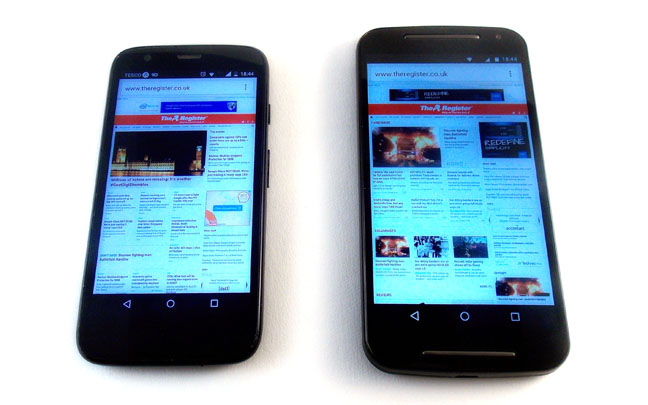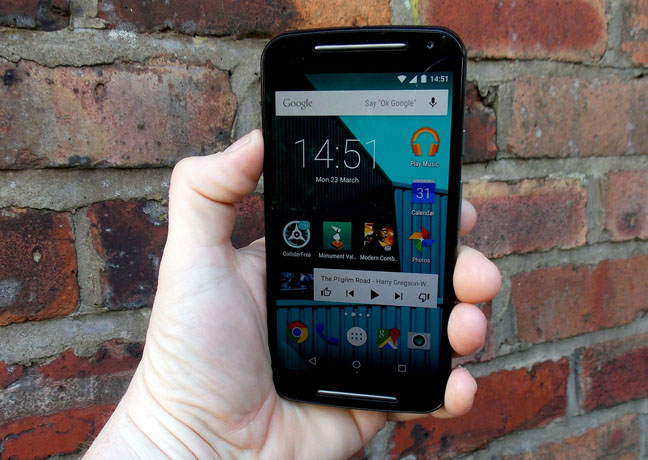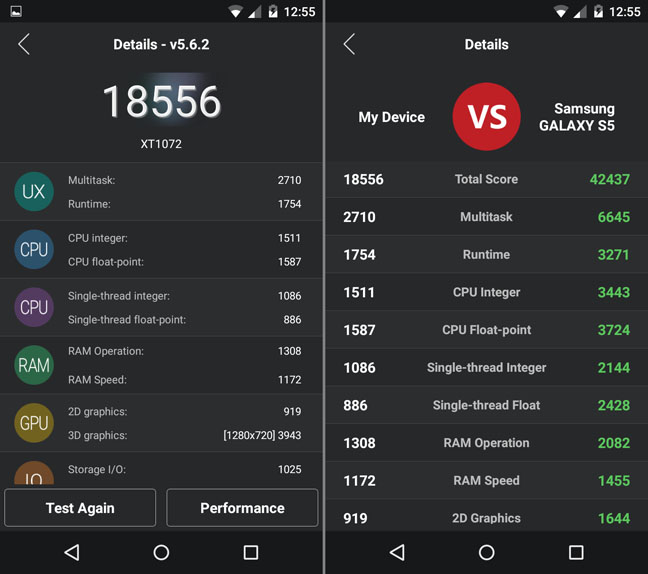This article is more than 1 year old
Motorola's 5-incher finds the G-spot: Moto G 4G budget Android smartie
Does it all and does it respectably, unless you want a fat camera
Happy snappy
A bigger screen and a larger battery mean a bigger phone. At 141.5 x 70.7 x 11mm, the new model is more than 10mm taller and 5mm wider than the original 4.5-inch handset and so is a little harder to use single handedly. It’s 0.6mm thinner though and only 12g heavier at 155g, so it’s not all bad news.

Moto G 4.5-inch model on the left, and new 5-inch version on the right. Both running Android 5.0
Two significant improvements over the 4.5-inch model involve the speakers and the camera. The latter was always a weakness of the Moto G. The 5MP main camera was mediocre to say the least. The new device uses an 8MP component and is certainly a big leap forward.
The new camera focuses faster, is much more detailed and more colourful. The flash is brighter too. What it still can’t do, though, is shoot video at 1080p which seems a like a missed opportunity, as the processor should be up to it. No doubt the limited internal storage has something to do with that restriction.
The front-facing stereo speakers are another worthwhile upgrade. Loud and composed, they wouldn't disgrace an HTC device with BoomSound written on the back. When it comes to loudspeaker performance the new Moto G humbles the far more costly Moto X which looks like it has two similarly arrayed speakers but doesn't.
Something the new 4G Moto G lacks is the second SIM card slot of the 3G version. This came as no surprise. Dual-SIM devices are targeted primarily at developing markets; 4G devices are not. It’s worth mentioning that a dual-SIM 4G Moto G (the XT1077/9 Titan) does actually exist but is exclusive to the Chinese market.

Bigger than the first Moto G, hence a little less cosy to use with one hand
Inside this latest Moto G lives a Qualcomm MSM8926 Snapdragon 400 chipset featuring a quad-core 1.2 GHz Cortex-A7 chip and an Adreno 305 graphics wrangler with 1GB of RAM. That’s more or less the same component that you’ll find in every other Moto G variant. It’s not by any means a new chipset. The MSM8926 is actually an LTE-supporting update of a SoC first announced back in late 2012. The benchmark scores are unsurprisingly nothing to write home about.
The AnTuTu test returned an average score of 18,556 which compares to the Mk.I Moto G’s score of 17,290. But times have moved on since 2013 and modern flagship devices like the Galaxy S6 now return scores of well over 45,000. An extra gigabyte of RAM would have helped here.

AnTuTu score reflects the chipset's age with not much improvement since December 2013
Benchmark numbers aside, the Moto G still has the chops to play pretty much any 3D game you'll find in the Play Store without getting its knickers in a twist. I worked my way through Gameloft's Modern Combat 5: Blackout with no problems.

